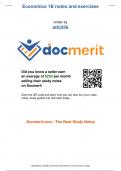Summary
Summary MANCOSA economics 1B notes and excercises
- Course
- Institution
This document offers a summary of economics 1B along with questions and answers related to the summary you will read. It explains in detail and in simple terms all the aspects of Economics 1B
[Show more]



